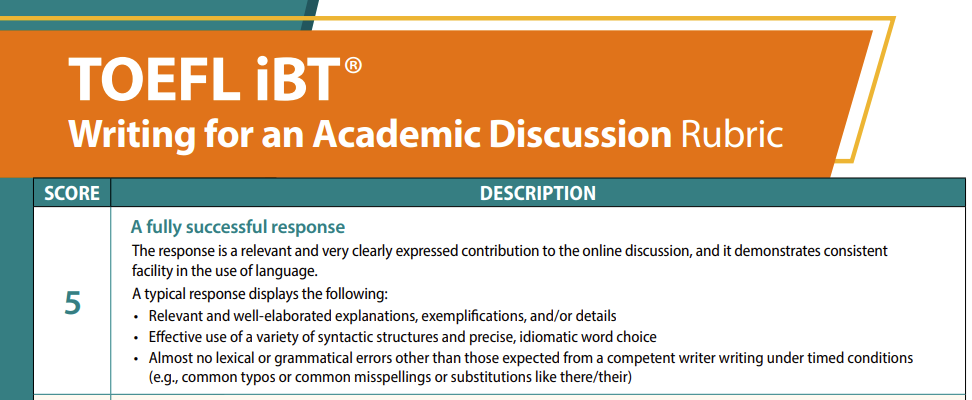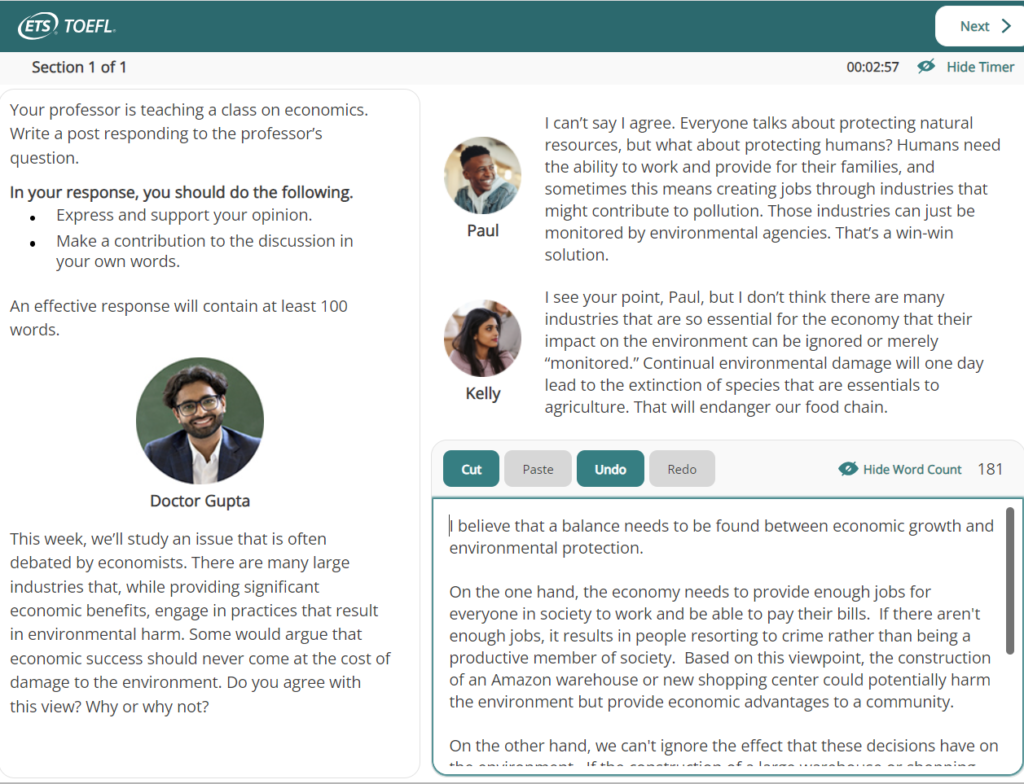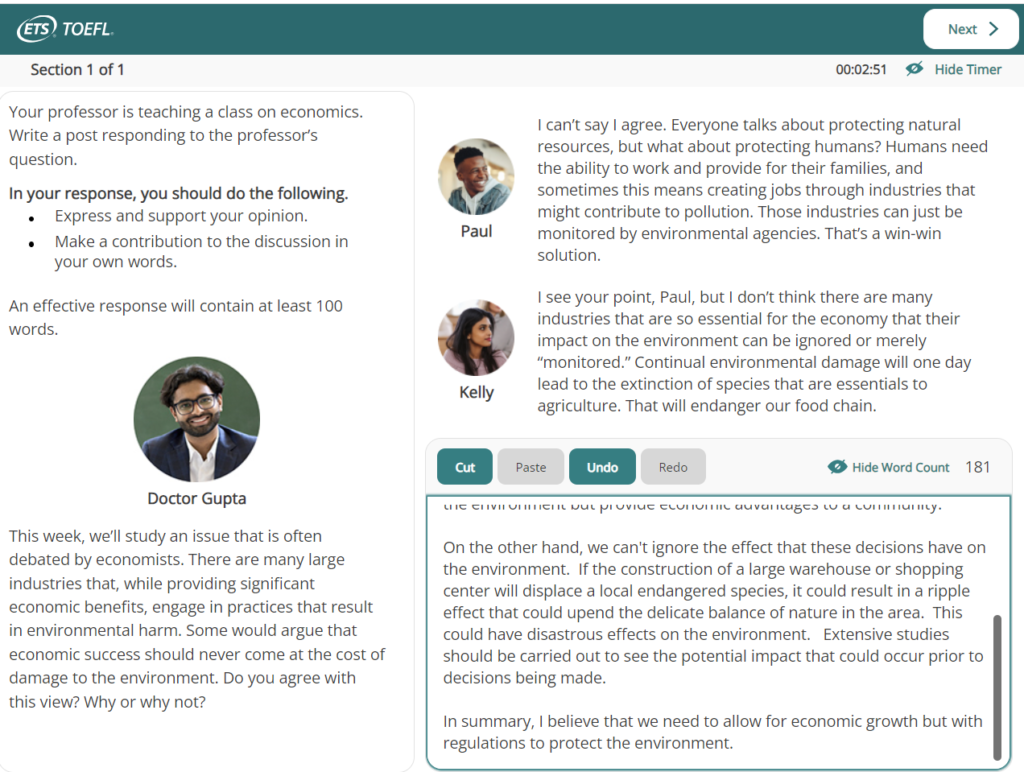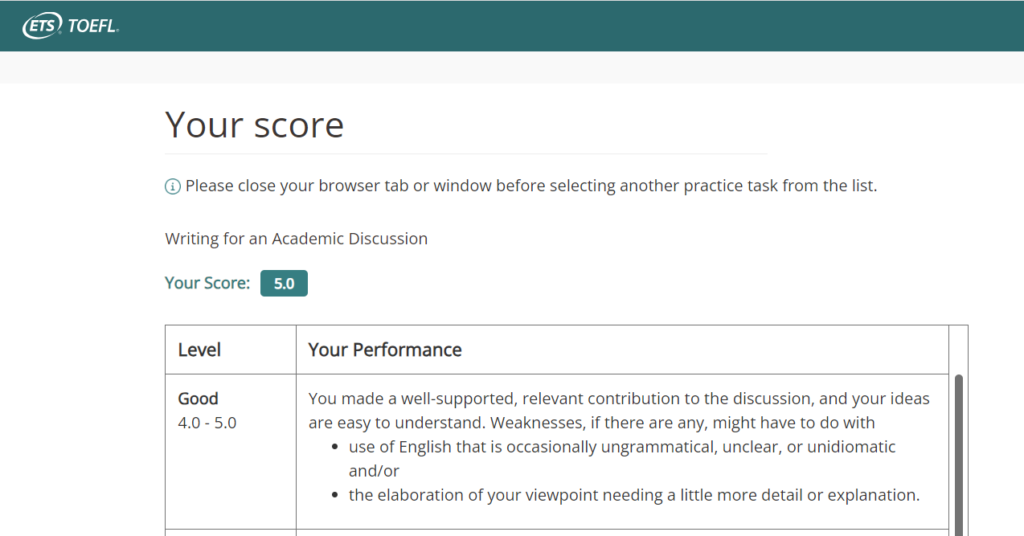In my last blog post I wrote about the changes to the format of TOEFL as well as the new writing task. In this post we’re going to take a look at the new writing task in more detail.
Before reading any further, I’d like to provide a few caveats:
- This writing task is less than a month old. Information may have changed between the time this article was published and when you’re reading it.
- This is based on my initial experiences. Since there are no official guides with model answers showing responses with different scores, it’s impossible to say exactly what you need to do to get a top score for this question.
How is the Writing for an Academic Discussion Task scored?
According to the ETS website, scores are given based on an AI analysis as well as a certified human scorer. This provides some comfort for me, as I’ve noticed some difficulties in AI understanding what I’ve written and unable to tell me why I received a score of 0 or a practice question.
First let’s look at what the highest score of 5.0 requires:

Let’s break down the key elements here one by one:
- A “clearly expressed contribution to the online discussion” means that clarity is important. One thing that I’ve noticed students struggle with is clearly taking a position or directly stating something.
- “Well-elaborated explanations, exemplifications, and/or details” shows that we need to give a complete response; the focus of this point is on content. Things like clear topic sentences, supporting details, and examples that illustrate our point are important here.
- “Effective use of a variety of syntactic structures and precise, idiomatic word choice” now moves us to looking at the structures and words that we use in our response. A score at this level means that we’re able to use things like simple, complex, and compound sentences in our writing. In addition, we’re able to use words that correctly convey the meaning.
- “Almost no lexical or grammatical errors….” indicates that we are able to write correctly under timed conditions. It is possible to make mistakes, but they are limited in order to receive a score of 5.
If you’d like to see the entire scoring rubric for this task, you can access it here.
What does a 5.0 response look like?
Here is the prompt and my response that I gave to a practice questions on the ETS website. My response doesn’t fit on one screen, so it is continued in the second screenshot.


And here is the score based on the AI evaluating my response:

Why do I think I received this score?
Based on the questions that I completed as well as looking at the rubric, here is what I think made this a successful response:
- My response takes a clear position that I directly state right from the beginning. In the context of an online discussion, we value brevity and clarity of ideas. This is in contract to writing an entire essay, and it’s something test takers will need to get used to.
- I use topic sentences to explain my opinion regarding both sides, and I elaborate stating why each idea is important. The example at the end of each paragraph gives the reader a concrete example that they can relate to.
- This response has syntactic variety. Phrases like on the one hand and on the other hard are effective connectors to help the response flow smoothly from one idea to the next. I also use the passive voice (a balance needs to be found, extensive studies should be carried out) and a variety of sentence structures.
- The vocabulary I use (also referred to lexis or lexical resource) shows an ability to communicate complex ideas in English easily within a time limit. This includes phrases like economic growth, environmental protection, disastrous effects, resorting to crime, and a productive member of society.
Based on this, what do test takers need to do and need to avoid to get the best score possible?
Based on this, I believe that test takers should do the following:
- Write a minimum of 120 and a maximum of 180 words. Looking back at my response, I could have eliminated the concluding sentence and probably gotten the same score.
- Organize your response into an opening sentence and a few short paragraphs. While there is no part of the rubric that states this, I find that doing so helps me organize my ideas. I can also see where I need to develop ideas more fully.
- Consider the viewpoints provided and give your own opinion based on what is said. You should be able to find synonyms or other phrases to reference what has already been said. In my response, I talked about environmental harm instead of environmental damage.
I believe that test takers should avoid doing a few things:
- Don’t use the students’ names or quote their ideas in your response. I believe that the second response I gave (seen in my last blog post) received a score of zero because I used too many words from the students’ posts, causing the AI to in effect disqualify my response.
- Don’t write more than 180 words. At that point, you’re getting to the length of a short essay, and your response could start to lose focus.
- Don’t write fewer than 120 words. If you’re doing so, it’s not likely that you are providing a complete response that will get the highest score that you’re capable of.
Final Thoughts
We don’t know how a human scorer will affect the scores that test takers receive based on the practice questions provided, so it will be interesting to see what test takers have to say about their experience.
As I stated before, we don’t have much to go off of since there are not official resources with model answers. It will be interesting to see how ETS will revise their official test prep materials for the new TOEFL test.
If you’ve take the new TOEFL, share your experience in a comment below.
If you need help preparing for TOEFL, feel free to leave a comment below or send me a message on my website contact form to get the process started.


